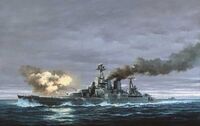
HMS Hood opening a can of whoopass on the Jerries and Ivans.
The Admiral-class battlecruisers were a class of four British Royal Navy battlecruisers designed near the end of World War I. Their design began as an improved version of the Queen Elizabeth-class battleships, but it was recast as a battlecruiser after Admiral John Jellicoe, commander of the Grand Fleet, pointed out that there was no real need for more battleships, but that a number of German battlecruisers had been laid down that were superior to the bulk of the Grand Fleet's battlecruisers and the design was revised to counter these. The class was to have consisted of HMS Hood, HMS Anson, HMS Howe, and HMS Rodney — all names of famous admirals — but the latter three ships were suspended as the material and labour required to complete them was needed for higher-priority merchantmen and escort vessels. Their designs were updated to incorporate the lessons from the Battle of Jutland, but the Admiralty eventually decided that it was better to begin again with a clean-slate design so they were cancelled in 1919. No more battlecruisers would be built due to the arms limitations agreements of the interbellum.
Hood, however, was sufficiently advanced in construction that she was completed in 1920 and immediately became flagship of the Battlecruiser Squadron of the Atlantic Fleet. She served as the flagship of the Special Service Squadron during its round-the-world cruise in 1923-24. Hood was transferred to the Mediterranean Fleet in 1936 and spent much of the next few years on Non-Intervention Patrols during the Spanish Civil War, returning to the United Kingdom before the beginning of World War II and the Battlecruiser Squadron of the Home Fleet.
Early in World War II, Hood underwent an extensive modernization with the following modifications:
- New internal machinery and improved subdivision. It was desirable to upgrade and relocate engines and boilers.
- Rearranged/remodelled torpedo bulges and side armour. Most likely the side bulges would have been extended to the top of the 7" armour belt rather than to the top of the 12" belt.
- Improved deck armour/protection over vital areas.
- Removal of armoured conning tower and the 5" side armour.
- New superstructure and masts fore and aft. Most notably, the forward superstructure would have been a "block" type similar to that of Renown, the Queen Elizabeths or the King George Vs (KGV).
- New funnels. These were something similar to those on Renown as the KGV funnels were too small.
- Addition of a catapult, dual hangars and Walrus seaplanes.
- Improved antiaircraft (AAA) protection. This would include the removal of all existing weaponry and replacement with a total of 6 Mark M eight-barreled pom poms, 14 QF 4" Mk.XIV DP guns, and 26 40mm Bofors AA guns
- Upgraded fire control. She would have received updated radar, fire control tables, comms, directors, etc.
- Extended forecastle deck. Hood's stern was notoriously wet due to her overweight condition. An extension was considered for the simple fact that it might help keep the quarterdeck a bit drier. The extension would retain the rough "V" shape but would instead, extend to "X" turret.
Specifications[]
Original Specifications[]
- Type: Battlecruiser
- Service Period: 1920-1950
- Characteristics:
- Length: 860 feet 7 inches (262.31 meters)
- Beam: 104 feet 2 inches (31.75 meters)
- Draught: 31 feet 6 inches (9.6 meters)
- Displacement: 41,125 tons (Standard); 46,680 tons (Full Load)
- Crew: 820
- Propulsion: four shafts, Brown-Curtis geared steam turbines, 24 Yarrow boilers, 144,000 shp
- Range: 7,500 nautical miles (13,890 kilometers) at 14 knots (25.93 km/h)
- Speed: 31 knots (57.41 km/h)
- Armament:
- 8 x BL 15"/42-caliber Mk.I naval guns
- 16 × BL 5.5"/50-caliber Mk.I naval guns
- 4 × QF 4"/45-caliber Mk.V anti-aircraft guns
- 10 × 21-inch torpedo tubes
- Armour:
- Belt: 5–12 in (127–305 mm)
- Decks: 1–5 in (25–127 mm)
- Barbettes: 12 in (305 mm)
- Turrets: 11–15 in (279–381 mm)
- Conning tower: 9–11 in (229–279 mm)
- Torpedo bulkheads: .75–1.5 in (19–38 mm)
Refit Specifications[]
- Type: Battlecruiser
- Service Period: 1920-1950
- Characteristics:
- Length: 860 feet 7 inches (262.31 meters)
- Beam: 104 feet 2 inches (31.75 meters)
- Draught: 31 feet 6 inches (9.6 meters)
- Displacement: 45,550 tons (Standard); 48,000 tons (Full Load)
- Crew: 820
- Propulsion: 8 x Admiralty 3-drum boilers, 4 x Parsons geared steam turbines, 4 x shafts, 151,200 shp (112,750 kW)
- Range: 8,000 nautical miles (14,816 kilometers) at 14 knots (25.93 km/h)
- Speed: 31 knots (57.41 km/h)
- Sensor Suite:
- Type 279 air-warning radar
- Type 284 gunnery radar
- Tachyometric RDF-based Air-Defense and Identification System (TRADIS)
- Armament
- 8 x BL 15"/45-caliber Mk.II naval guns (4x2)
- 14 x QF 4"/45-caliber Mk.XVI dual purpose naval guns (7x2)
- 26x 40mm Bofors Anti-Aircraft Guns (12x1, 5x2, 1x4)
- 48x 40mm QF 2-Pounder Mk.VI Pom-Pom Anti-Aircraft Guns (8x6)
- Armour:
- Belt: 14-inches (355.6 mm)
- Decks: 8-inches (203.2 mm)
- Bulkheads: 10-inches (254 mm)
- Barbettes: 12-inches (305 mm)
- Turrets: 15-inches (381 mm)
- Conning tower: 11-inches (279 mm)
- Torpedo bulkheads: 2-inches (51 mm)
Unit Run[]
- HMS Hood - museum ship from 1950 onwards, stationed at HMNB Scapa Flow.
- HMS Anson - cancelled because of the 1920 Washington Naval Treaty
- HMS Howe - cancelled because of the 1920 Washington Naval Treaty
- HMS Rodney - cancelled because of the 1920 Washington Naval Treaty